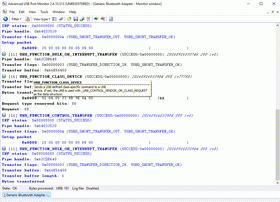Advanced USB Port Monitor is USB bus, USB device and protocol analyzer software.
For Windows 2000 - Windows 11 (2022) (incl. Server, x86 and x64). Latest version: 2.8.1 build 1115. November 15, 2023.
Features:
USB sniffer. The USB sniffer mode allows you to capture data exchange between other programs and an external device.
Faster interpretation of USB traffic. Allows to use the program with fast USB devices, such as USB disks, USB cameras, etc.
Kernel driver technology with the support of WDM, WMI, Power Management, PNP, etc. Allows to reach complete compatibility with the operating system and USB devices, thus provide maximum operating speed.
Real-time monitoring, logging, and viewing. With the help of Advanced USB Port Monitor you can view traffic for multiple USB devices simultaneously, at the same moment when a data flow arises.
Measure the performance of your USB devices. The performance monitor window allows you to evaluate the parameters of the data flow that your device generates or can generate.
Configurable filtering. Automatically exclude non-essential and redundant packets from the monitoring.
Sophisticated viewing. View URB packets of the USB protocol and IRPs of the PnP system, Power management system, etc. You can select the refinement level of data viewing and get tooltips for keywords in the monitor window.
Detailed USB devices tree. View, explore and browse USB devices and their related devices such as USB drives, with a possibility to view detailed information about a USB device (interfaces, endpoints, registry information, class information, etc. It is a report of two pages!).
Print all information. View and print detailed information about each USB device, URB or IRP.
Custom user-defined workspaces. You can save the configuration of your workspace during the current session of working with the program. It allows you to save your settings between sessions easily. You can create, delete and save workspaces manually.
Data export functions (PDF, XML, Microsoft Word). It allows you to save the reports or data to a file with other formats for post-processing.

